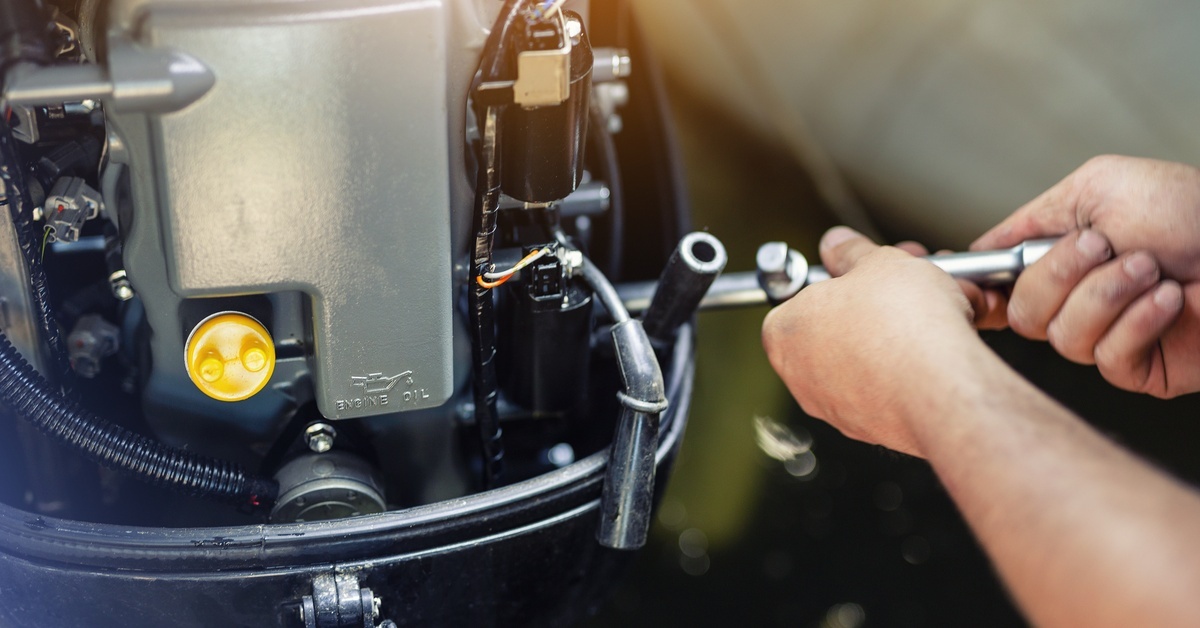The Basics of Reading Your Boat’s Engine Warning Lights

Your Yamaha outboard motor, as it powers your boat, is constantly monitoring itself. It’s “watching” dozens of systems and sensors to catch problems before they become disasters. When something goes wrong, your engine communicates through warning lights, alarm tones, and diagnostic codes stored in its engine control unit (ECU).
We’re here to teach you how to interpret these signals. Read on to explore the basics of reading and reacting to your boat’s Yamaha engine warning lights.
Dashboard Warning Lights
Yamaha outboards feature indicator lights on your dash or gauge cluster that serve as your most immediate visual alerts. While the exact symbols may vary depending on your specific model and year, several warning lights appear across most systems.
Check Engine Light (Malfunction Indicator Lamp)
This yellow or amber light typically resembles an engine block or displays a generic “check” symbol. When illuminated, it signals that the ECU has detected a fault in one of your engine’s systems. The issue might be relatively minor—perhaps a sensor reading slightly out of range—or it could indicate something more serious developing beneath the surface.
The tricky part about the check engine light is that your engine might feel perfectly normal even when it’s on. You won’t necessarily notice any performance changes or unusual sounds. However, the light means a fault code has been stored in your ECU that requires attention. Address it promptly rather than waiting for the problem to worsen.
Engine Temperature Warning Light
Usually appearing as a red thermometer icon or a stylized boat with wavy lines, this warning demands immediate action. It means your engine’s operating temperature has climbed too high. Overheating can warp cylinder heads, damage gaskets, or seize internal parts, and these are repairs that often cost thousands of dollars.
The moment you see this light, reduce the throttle immediately and prepare to shut down safely. Check whether your tell-tale stream (the small stream of cooling water that exits near the engine) is flowing normally. A weak or absent tell-tale often points to a cooling system blockage or water pump failure.

Low Oil Pressure or Oil Level Warning
This red light, typically showing an oil can or droplet icon, indicates critically low oil pressure in four-stroke engines or dangerously low oil levels in two-stroke engines with oil injection systems. Oil is the lifeblood of your engine—it lubricates moving parts, reduces friction, and helps dissipate heat. Running without adequate oil pressure can destroy an engine in minutes.
If this light appears, reduce the throttle and shut down your engine as soon as you can do so safely. Check your oil level and add oil if necessary before attempting to restart.
Low Battery Voltage or Charging System Warning
A battery icon on your dash means the battery voltage has dropped too low or there’s a problem with your charging system—typically the alternator or rectifier.
The immediate solution is to reduce your electrical load by turning off nonessential accessories. Keep the engine running if possible to allow the charging system to work, but head back to port soon. A fully drained battery won’t let you restart your engine.
Water in Fuel Warning
This light, which may appear as a fuel filter with a water droplet or wavy lines, indicates that water has been detected in your fuel filter or separator. Water contamination can cause rough running, power loss, or complete engine failure. Furthermore, water promotes corrosion inside fuel system components, injectors, and the combustion chamber.
Stop the engine as soon as is practical. Your fuel filter needs to be drained or replaced before you continue operating.
Audible Alarms To Listen For
Yamaha outboards supplement visual warnings with audible alarms—sounds you definitely don’t want to hear while underway. These beeps provide critical information about the severity of the problem.
Continuous Beeping
A steady, continuous alarm indicates a critical fault requiring immediate attention. This alarm typically activates in conjunction with your engine’s Guardian System or limp mode—safety features that reduce power automatically to prevent catastrophic damage. Common triggers include severe overheating, critically low oil pressure, or major sensor failures.
When you hear continuous beeping, reduce the throttle immediately and prepare to shut down. Don’t attempt to power through this alarm or override the reduced power mode.
Intermittent Beeping Patterns
Intermittent beeps—such as four beeps repeating every two minutes—usually signal noncritical but important warnings. These patterns might indicate low oil in your engine-mounted reservoir (for two-stroke models), water in the fuel filter, or minor sensor issues. While these warnings allow you to safely return to port, they’re telling you to address something soon before it becomes a bigger problem.
Always consult your owner’s manual to understand the specific beep patterns programmed into your particular Yamaha model.

Diagnostic Trouble Codes: The Engine’s Detailed Report
Behind every warning light lies a specific diagnostic trouble code stored in your ECU. These codes provide detailed information about what triggered the warning, making diagnosis much faster and more accurate.
Accessing Fault Codes
Modern digital gauge systems like Yamaha Command Link can display active and stored fault codes directly on screen, giving you immediate insight into what’s happening. Older or simpler systems may use blink codes, where the check engine light flashes in specific patterns (for example: two blinks, pause, three blinks equals code 23). Your owner’s manual explains how to put your particular engine into diagnostic mode.
Marine mechanics use specialized diagnostic tools—such as the Yamaha Diagnostic System (YDS)—that connect directly to your engine’s ECU. These tools read all active and historical fault codes, plus display live sensor data that helps pinpoint intermittent problems.
Interpreting the Codes
Diagnostic codes are typically alphanumeric identifiers (like P0171 or Code 4-1) that correspond to specific system or component faults. For instance, you might see codes indicating “System Too Lean,” or “Incorrect Throttle Position Sensor Signal.”
These phrasings can be confusing. If you’re committed to handling the issue on your own, then refer to your owner’s manual for the most reliable code definitions for your specific engine. However, professional assistance is always the safest, quickest bet when it comes to interpreting and addressing these fault codes.
Keep Your Yamaha Running Strong With Professional Support
Knowing how to read your boat’s Yamaha engine warning lights is valuable, but there’s no substitute for professional expertise when issues arise. Maybe you’re dealing with persistent warning lights or diagnostic codes you can’t interpret. Or perhaps you simply want preventive maintenance to avoid problems altogether. Whatever the case, RJ Nautical provides comprehensive Yamaha outboard service.
Our certified technicians have the specialized diagnostic tools, training, and experience to quickly identify and resolve issues with your Yamaha outboard. From routine maintenance to complex repairs, we’re committed to keeping you on the water with confidence. Contact RJ Nautical today to schedule your service and experience the difference that expert care makes.
